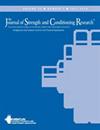摘要
摘要:Naclerio,F;Larumbe-Zabala,E;Chapman,M;Gonzales-Frutos,P;Triplett,NT。比较卧推中使用速度反馈或感知用力的阻力训练刺激。J Strength Cond Res 39(4):399-406,2025--我们比较了速度反馈法(VEL)与感知反应法(RPE)(无速度反馈),以估算在卧推练习中以速度下降 10%、20% 和 40% 为终点的连续组中运动速度的变化,使用的是 50%或 75% 的单次最大重量(1RM)。经过 5 次熟悉和确定 1RM 后,19 名男性(24.5 ± 6 岁)和 9 名女性(30.4 ± 8 岁)在 2 周内(共 12 天)进行了 2 次相同的 6 天测试,采用 VEL 法(前 6 次)或 RPE 法(后 6 次)。测量了每组重复的平均速度和阻力运动的 OMNI 感知运动量表(OMNI-RES)(0-10)分值。在 VEL 条件下,在低于预先设定的速度阈值的情况下完成连续 2 次重复后,成套动作终止。在 RPE 条件下,当受试者达到先前获得的与特定测试速度阈值相关联的 OMNI-RES 分数时,成套动作停止。采用线性混合效应模型,将速度阈值、方法及其交互作用设为固定效应,将受试者设为随机成分。在速度下降的绝对值(m-s-1)和百分比或使用 50% 和 75% 1RM 的总重复次数方面,没有观察到不同方法之间存在差异(P > 0.05)。然而,与 VEL 相比,在 RPE 下完成的与不良神经肌肉适应有关的重复次数更少(p < 0.01)。总之,虽然估计速度变化的方法之间没有发现差异,但 RPE 可能比 VEL 方法更适合减少在规定阈值下完成的重复次数。Abstract: Naclerio, F, Larumbe-Zabala, E, Chapman, M, Gonzales-Frutos, P, and Triplett, NT. Comparing the resistance training stimuli using velocity feedback or perceived exertion in bench press. J Strength Cond Res 39(4): 399-406, 2025-We compared the velocity feedback method (VEL) vs. the perceptual response (RPE), with no velocity feedback, to estimate changes in movement velocity during continuous sets terminated at 10, 20, and 40% of velocity decreases in the bench press exercise using either 50% or 75% of the 1 repetition maximum (1RM). After 5 sessions of familiarization and determining the 1RM, 19 males (24.5 ± 6 years) and 9 females (30.4 ± 8 years) underwent 2 identical 6-day testing sessions over 2 weeks (12 days in total) using the VEL (first 6 sessions) or the RPE method (last 6 sessions). The average velocity and the OMNI Perceived Exertion Scale for Resistance Exercise (OMNI-RES) (0-10) scale score were measured for every repetition of each set. Under VEL, the sets terminated after completing 2 consecutive repetitions below the pre-established velocity threshold. During RPE, the sets stopped when the subjects reached a previously obtained OMNI-RES score linked to the specific tested velocity thresholds. A linear mixed-effects model setting velocity thresholds, method, and their interaction as fixed effects and subjects as random components was conducted. No differences (p > 0.05) between methods were observed for the absolute (m·s-1) and percentage of velocity decreases or the total number of repetitions using both 50 and 75% of 1RM. Nonetheless, compared with VEL, fewer repetitions (p < 0.01) linked to nondesirable neuromuscular adaptations were completed under RPE. In conclusion, although no differences between methods for estimating changes in velocity were identified, the RPE could be preferable to the VEL method to reduce the number of repetitions performed under the prescribed threshold.

 求助内容:
求助内容: 应助结果提醒方式:
应助结果提醒方式:


